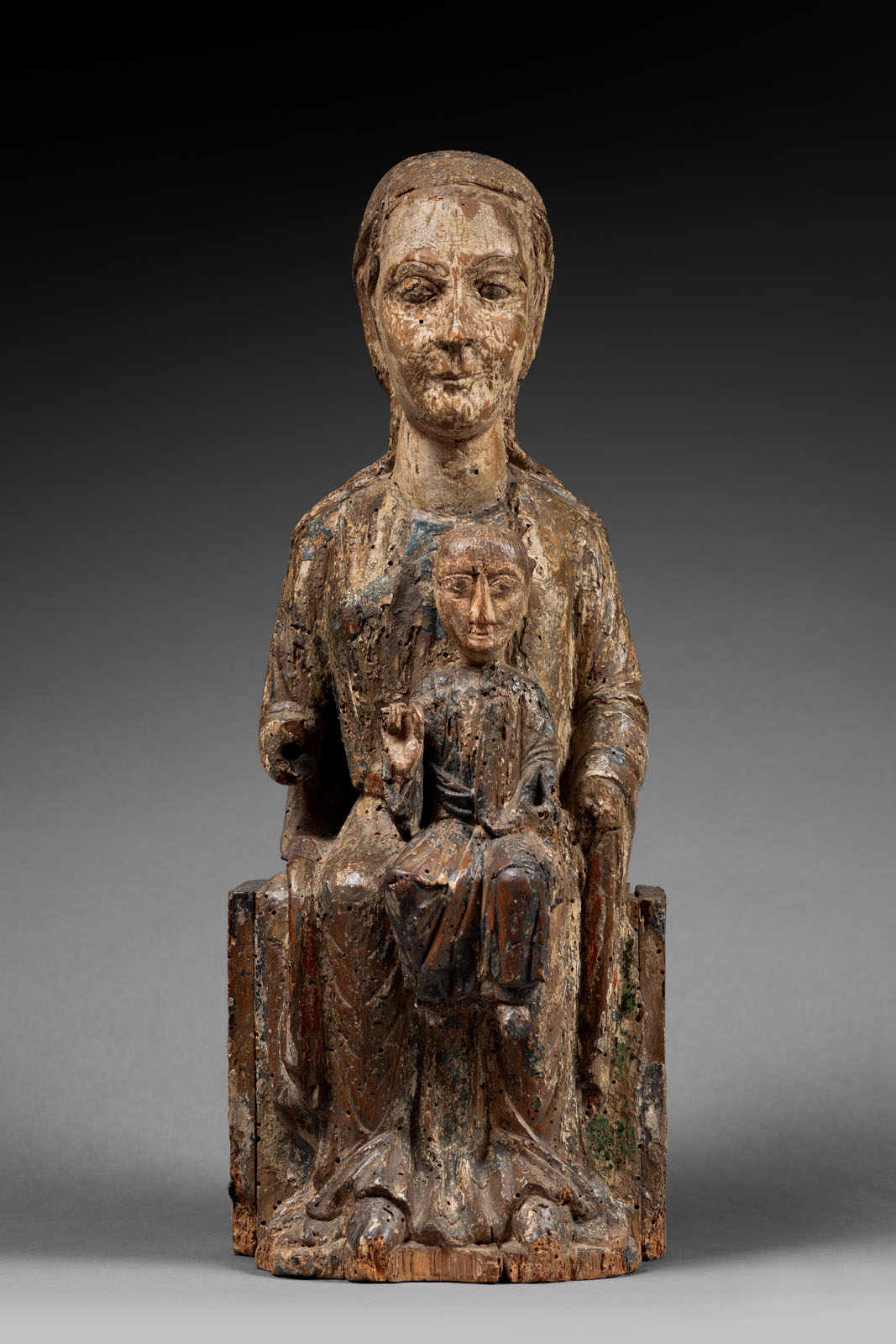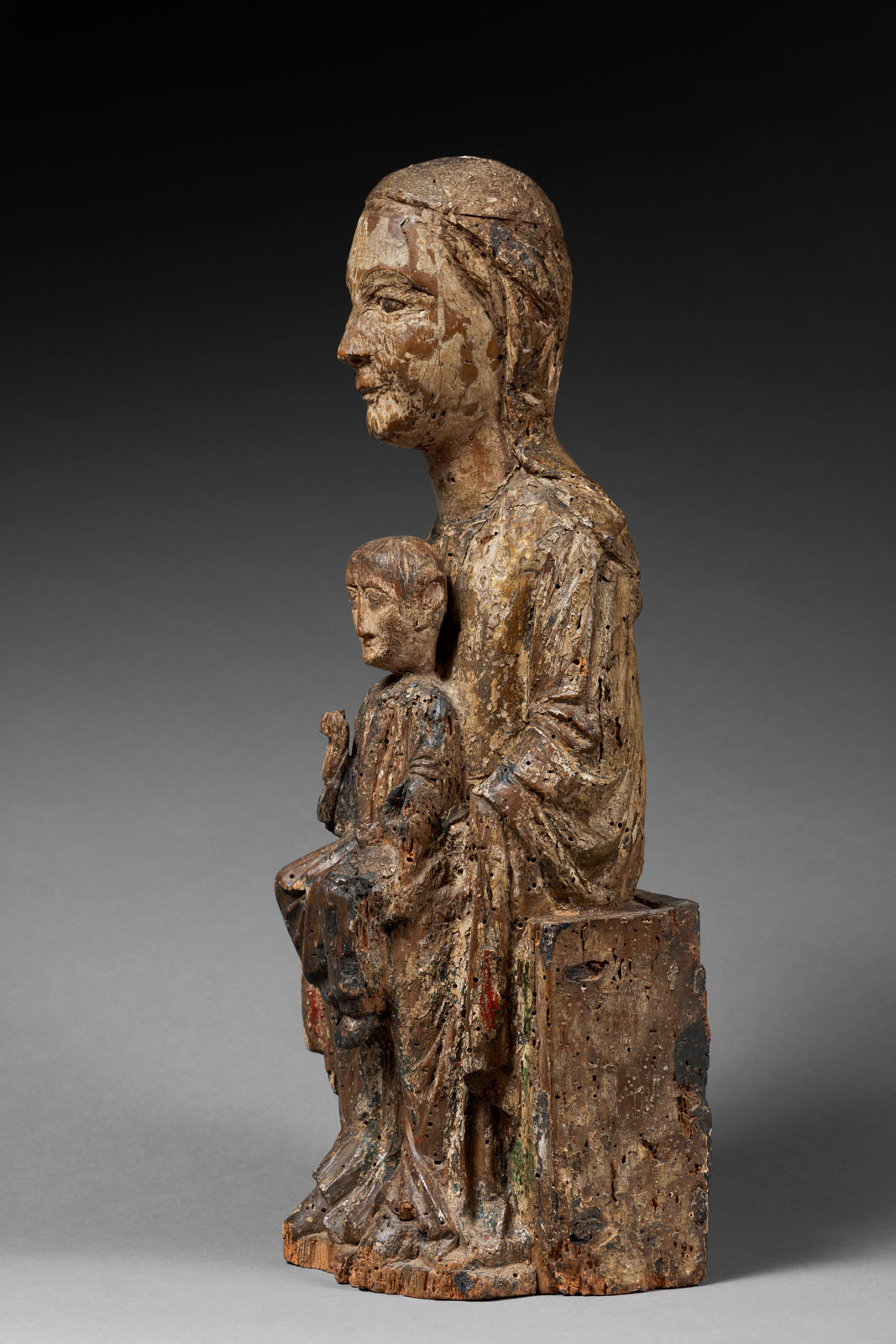Description
From the 12th century onwards Marial devotion becomes paramount. Main intercessor between people and God, the Virgin Mary holds a special position within churches where she seats in majesty. Taking place on a throne-bench she is then figured strictly frontally, her body acting in turn as a throne for her Son the Saviour. She embodies this quote from Saint John of Damascus :
“Her hands will carry the Eternal and her knees will be a throne…”
She is then designated as Sedes Sapientiae meaning Throne of wisdom. This theme of Virgin and Child in majesty was one of the most popular during Middle-Ages. Pilgrimages encouraged it development and the spreading of models all across Europe. We can find examples in France, Germany, Belgium, Scandinavia, England, Italy, Spain,…
This Virgin and Child is seated on throne-bench of which we can see the two jambs. She wears supple draped clothes. The dress is belted at the waist and shows a round collar. The slender vertical pleats are regular. A cloak covers her shoulders.
She presents a beautiful face with delicate features. Her hair is covered with a veil reaching her back.
The Virgin presents the Child Jesus on her knees in a frontal position. The Child is slightly off-centred on His mother’s left knee.
Following the canonical iconography Jesus wears the pallium, a garment worn by the first Christians.
He raises His right hand in a gesture of blessing.
This Virgin and Child is an exceptional sculpture from the late 12th century. As it is common with Romanesque majesties of the first half of the 12th centuries, the attitude is strictly frontal, hieratic with no communication displayed between the mother and the Son. Mary only exists to present her Child, as a Throne of Wisdom. The Child retains a majestic demeanour, blessing the worshippers; an iconography influenced by Byzantine depictions of Christ Pantocrator.
However the position of the Child, slightly off-centred on His mother’s left leg, displays a variation in the iconographical model. This evolution appeared only in the last period of the Romanesque age and thus allows us to date the conception of this statue around the late 12th century. Indeed, it forecasts an evolution that will soon lead artists of the 13th century to depict Christ seated on only one leg of His mother. The perception of Mary herself evolves too and Marial devotion from then on embraces her, not solely as a throne for her Son, but for her own greatness and mightiness.
VIRGIN IN MAJESTY, A SYMBOLIC DEPICTION
Depictions of the Virgin and Child find their origin in a very long tradition going all the way back to pagan deities such as Gallo-Roman mother goddesses. Those depictions appear as a synthesis of previous centuries’ art, answering the devotee’s desire for worshipping and protection.
Since the Council of Nicaea in 352 AD the question of Christ’s true nature is debated. The Council of Ephesus in 431 AD eventually ends the uncertainties by proclaiming His double nature. Christ is both human and godly. Those two essences are united in His person through the mystery of the incarnation. From then on the Virgin Mary is called Theotokos, Mother of God. A vivacious Marial devotion appears and grows for the centuries that succeed.
It is in Western Asia that the first Christians produce the earliest depictions of the Virgin in Majesty. In Europe they are represented in illuminated manuscripts before being carved in stone at the tympanum of cathedrals.
As early as the 9th century the Virgin and Child are carved in wood, in the round, sometimes covered with plaques of precious metals to be offered to the worshipper’s devotion. The oldest one was perhaps the one in Clermont’s cathedral around 946, known thanks to written sources. This statue unfortunately didn’t survive to our days. However it is very likely that it acted as a model for all the Majesties that followed.
The humane and maternal figure of the Virgin Mary allowed a bond of intimacy with the worshippers and came in opposition to the fear raised by God. However, as the mother of the Child God she remains hardly accessible. This dichotomy is particularly evident in the works of the 12th century. As a mother, Mary carries her Son on her laps. As the mother of God, she is the seat of the Divine Wisdom incarnation – Sedes Sapientiae. In this way, the mystery of the incarnation is made understandable to the worshippers, illustrating both the divine and humane nature of Child Jesus.
Regarding Majesties made during the 12th century, the Child is at the centre of focus. Thus the Virgin Mary is here to present the Child. She is subordinated to her Son while as a Mother she embodies the House of David, the human lineage of the Saviour.
This symbolic depiction is rich in meanings. It illustrates the mystery of sacred art. In the spirit of Romanesque period, the Sedes Sapientiae was the tangible representation of the divine hierarchy.
Literature
Abbé Laurentin et René Oursel, Vierges romanes, les vierges assises, Zodiaque, 1988
Jacqueline Boccador, Edouard Bresset, Statuaire médiévale de collection, tome I, Les clefs du temps, 1972


